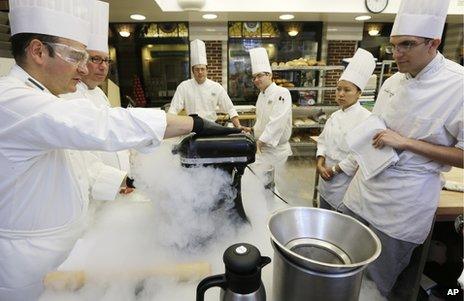Who What Why: How dangerous is liquid nitrogen?
- Published

A teenager has had her stomach removed after drinking a cocktail containing liquid nitrogen. So what exactly is liquid nitrogen, how is it used, and how careful do you need to be with it?
Liquid nitrogen, which has a boiling point of -196C, is used for a variety of things, such as a coolant for computers, in medicine to remove unwanted skin, warts and pre-cancerous cells, and in cryogenics, where scientists study the effect of very cold temperatures on materials.
It has also become increasingly common at top restaurants as a method for instantly freezing food and drinks, or creating an impressive cloud of vapour or fog when exposed to air.
The avant-garde cooking technique was arguably made famous by chef Heston Blumenthal, who put nitro-scrambled egg and bacon ice-cream and nitro-poached aperitifs on the menu at his Berkshire restaurant, The Fat Duck.
Since then a number of restaurants have started using the technique, with a cursory internet search throwing up recipes for nitro-caramel popcorn and pumpkin pie ice-cream (made with liquid nitrogen) among others.
Professor Peter Barham, from the University of Bristol's School of Physics, says liquid nitrogen is "simply the harmless gas nitrogen, which has been cooled to such a low temperature that it becomes a liquid".
But he says the liquefied gas, which is intensely cold, can cause frostbite or cryogenic burns if it is not used, and handled, properly.
For laboratory personnel in particular, there is also the risk of asphyxiation if liquid nitrogen - which is colourless, odourless and tasteless - is used or spilled in a confined space. Lab worker James Graham died from asphyxiation in 1999, external.
Liquid nitrogen also has a large expansion ratio on evaporation - one litre of liquid nitrogen can result in about 700 litres of gas - so only a relatively small volume of liquid nitrogen has to evaporate within a room to result in an oxygen deficient atmosphere. Pressure can build up in a sealed container due to the boil-off of nitrogen gas, so insulated vacuum-jacketed pressure containters are used to store it.
When it comes to using liquid nitrogen in cooking, Professor Barham says it is fine so long as safety measures are taken.
"If liquid nitrogen is added to a liquid such as an ice-cream mixture, it cools the liquid rapidly while it boils away and produces a cloud of vapour.
"The technique is used by some restaurants to prepare instant ice creams at the table - the rapid freezing produces an ice cream with particularly small ice crystals which has a very smooth texture," he says.
But Professor Barham adds that just as no-one would drink boiling water or oil, or pour it over themselves, no-one should ingest liquid nitrogen.
It is also essential that all the liquid has evaporated before any food or drink that has been prepared with liquid nitrogen is used, he says.
Science writer and fellow at the Royal Society of Chemistry John Emsley says if more than a "trivial" amount of liquid nitrogen is swallowed, the result can be horrendous.
"If you drank more than a few drops of liquid nitrogen, certainly a teaspoon, it would freeze, and become solid and brittle like glass. Imagine if that happened in the alimentary canal or the stomach.
"The liquid also quickly picks up heat, boils and becomes a gas, which could cause damage such as perforations or cause a stomach to burst," he says.
However, Emsley says he would be surprised if anyone could actually swallow that much liquid nitrogen.
"It would be extremely cold in anyone's mouth - people would want to spit it out immediately," he says.
But Dr Alex Valavanis, a research fellow at the Institute of Microwaves and Photonics, at the University of Leeds, believes it would be perfectly possible for someone to swallow a mouthful before they became aware of any ill effects, as liquid nitrogen "does not immediately feel cold".
He says the delay in feeling the cold is down to the "Leidenfrost effect" - which happens when a liquid, in near contact with a mass significantly hotter than the liquid's boiling point, produces an insulating vapour layer.
But he agrees a mouthful of liquid nitrogen - which would turn into about 25 litres of gas - could do "catastrophic damage".
While Emsley thinks the liquefied gas is safe in the hands of top chefs, and trained bartenders may be able to use it to create "sensational effects", he says there needs to be "a very strong warning not to play with it".
"It can be a bit of a novelty in the hands of experts, but it would be a different territory in the hands of the general public.
"If a few drops fell on your finger it would immediately boil and roll away, the finger probably wouldn't come to much harm.
"But if you put your finger in liquid nitrogen, it would go rock solid and fall off," he says.